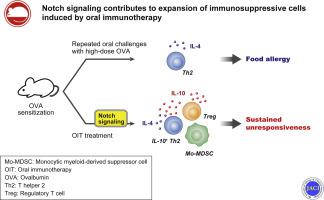Journal of Allergy and Clinical Immunology ( IF 11.4 ) Pub Date : 2020-07-24 , DOI: 10.1016/j.jaci.2020.07.011 Toshiyuki Yoneyama 1 , Nobuhiro Nakano 2 , Mutsuko Hara 2 , Hiromichi Yamada 1 , Kumi Izawa 2 , Koichiro Uchida 3 , Ayako Kaitani 2 , Tomoaki Ando 2 , Jiro Kitaura 2 , Yoshikazu Ohtsuka 1 , Hideoki Ogawa 2 , Ko Okumura 2 , Toshiaki Shimizu 1

|
Background
Oral immunotherapy (OIT) aims to establish desensitization and sustained unresponsiveness (SU) in patients with food allergy by ingestion of gradually increasing doses of specific food allergens. However, little is known about the mechanisms by which OIT induces SU to specific allergens.
Objectives
We investigated the role of Notch signaling, which controls cell fate decisions in many types of immune cells in the induction of SU by OIT treatment.
Methods
Two types of mouse models, ovalbumin-induced food allergy and OIT, were generated. To elucidate the role of Notch signaling in OIT-induced SU, mice were intraperitoneally injected with the Notch signaling inhibitor N-[(3,5-difluorophenyl)acetyl]-l-alanyl-2-phenylglycine-1,1-dimethylethyl ester during the OIT treatment period.
Results
Ovalbumin-sensitized mice were desensitized and also had SU induced by OIT treatment, whereas repeated challenges with ovalbumin caused the development of severe allergic reactions in ovalbumin-sensitized mice. Administration of N-[(3,5-difluorophenyl)acetyl]-l-alanyl-2-phenylglycine-1,1-dimethylethyl ester to mice during the OIT treatment period inhibited the establishment of SU to ovalbumin but did not affect the induction of desensitization. OIT induced a systemic expansion of IL-10–producing CD4+ T cells, including TH2 cells, and myeloid-derived suppressor cells (MDSCs), particularly the monocytic MDSC subpopulation. Inhibition of Notch signaling prevented the OIT-induced expansion of those cells. In vitro cultures of bone marrow cells showed that Notch signaling directly promoted the generation of monocytic MDSCs. In addition, the contribution of MDSCs to OIT-induced SU was confirmed by MDSC depletion with the anti-Gr1 antibody.
Conclusion
Notch signaling contributes to the establishment of SU induced by OIT through systemic expansion of immunosuppressive cells, such as IL-10–producing CD4+ T cells and MDSCs.
中文翻译:

Notch信号有助于通过口服免疫疗法建立对食物过敏原的持续无反应
背景
口服免疫疗法 (OIT) 旨在通过摄入逐渐增加剂量的特定食物过敏原,在食物过敏患者中建立脱敏和持续无反应 (SU)。然而,关于 OIT 诱导 SU 对特定过敏原的机制知之甚少。
目标
我们研究了 Notch 信号的作用,它控制着许多类型的免疫细胞在 OIT 处理诱导 SU 中的细胞命运决定。
方法
生成了两种类型的小鼠模型,卵清蛋白诱导的食物过敏和 OIT。为了阐明 Notch 信号在 OIT 诱导的 SU 中的作用,小鼠腹腔注射 Notch 信号抑制剂N -[(3,5-二氟苯基)乙酰] -l-丙氨酰-2-苯基甘氨酸-1,1-二甲基乙酯。 OIT 治疗期。
结果
卵清蛋白致敏的小鼠被脱敏并且还具有由 OIT 治疗诱导的 SU,而卵清蛋白的反复攻击导致卵清蛋白致敏小鼠发生严重的过敏反应。在OIT治疗期间给小鼠施用N -[(3,5-二氟苯基)乙酰基] -l-丙氨酰-2-苯基甘氨酸-1,1-二甲基乙酯可抑制SU对卵清蛋白的形成,但不影响其诱导脱敏。OIT 诱导产生 IL-10 的 CD4 + T 细胞(包括 T H 2 细胞)和髓源性抑制细胞 (MDSC),尤其是单核细胞 MDSC 亚群的系统扩增。Notch 信号的抑制阻止了 OIT 诱导的这些细胞的扩增。体外骨髓细胞培养显示 Notch 信号直接促进单核细胞 MDSCs 的产生。此外,MDSCs 对 OIT 诱导的 SU 的贡献通过抗 Gr1 抗体消耗 MDSC 得到证实。
结论
Notch 信号通过免疫抑制细胞(如产生 IL-10 的 CD4 + T 细胞和 MDSC)的系统扩增,有助于 OIT 诱导的 SU 的建立。









































 京公网安备 11010802027423号
京公网安备 11010802027423号